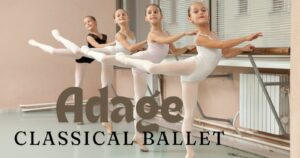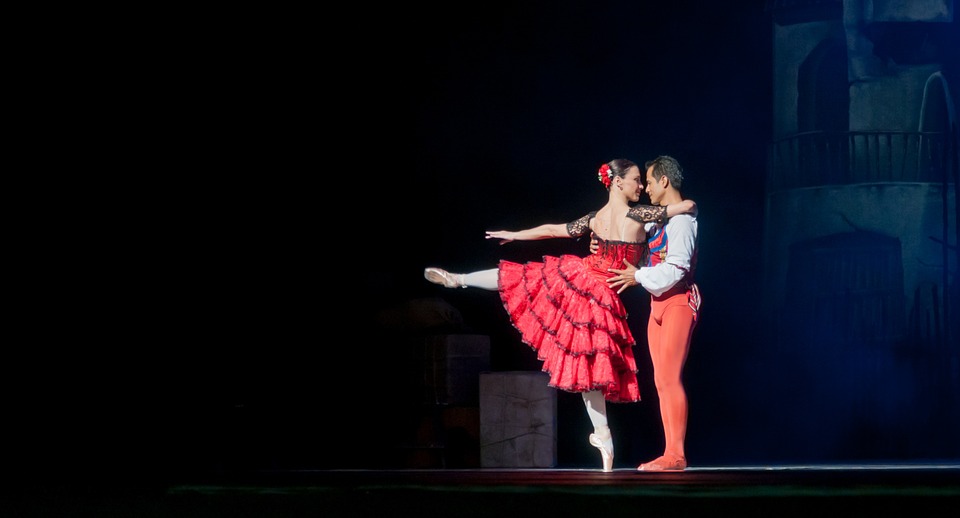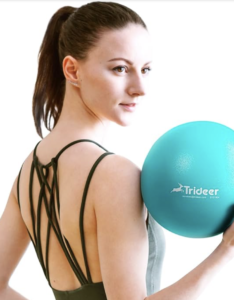Definition Adage
If you type in ‘definition adage‘ or ‘definition adagio‘ you will be surprised that it means a proverb or short statement expressing a general truth: The old adage “out of sight out of mind.”
If you are looking for the meaning within ballet you will need to specify further.
The definition adage in the ballet world describes slow and lyrical dancing performed with fluidity and grace. Most schools of ballet use the definition adage, while the Italian musical term ‘adagio’ is also used in some schools, which means at ease, or at leisure.
A dancer’s line, extension, balance, coordination, turnout, and control are all put to the test during adage as she moves with slow, fluid serenity from one position to the next, all while trying to look and feel at ease.
Adage is one of the most difficult things to get perfect in the art of ballet.

Why is Adage Used In Ballet?
Adage work is used in a lot of ballet productions, and it is emphasized more so in the big romantic ballets like Swan Lake and Romeo and Juliet.
Adage is used to tell stories, as well as show off the dancer’s technical precision. Adage is a slow series of exquisite lines which require great balance, strength, coordination, and control from the dancers.
What would Swan Lake or Sleeping Beauty be without the famous romantic adages. One of the best-known adages is done in The Sleeping Beauty in the Rose Adagio. Here Princess Aurora has to perform a series of balances with four ardent suitors. This is a beautiful example of the Rose Adagio.
In the ballet Gizelle, Gizelle rises from her grave with a slow and sustained developpe a la seconde and using a series of adage movements communicates the heartbreak and the horror of her fate.
Adage is used to stir emotion out of the audience in most ballets, as ballet is normally at its most expressive during the adagio sections.
Adage Technique
To make adage look great, dancers need to pay attention to the beauty of their lines and the fluidity of their movements. A lot of the adage is practiced at the barre from a young age – plie, developpe, fondu, attitude, arabesques, and penché to mention a few.
When the dancer moves to the center floor work the steps are connected and they are practiced using different directions. The balance of the dancer needs to be worked on continuously here.
Here are some things a dancer can do to improve her adage work:
- Make sure you warm up thoroughly before attempting any high lifts with the legs.
- If your arabesques are wobbly practice these on your own at home by stepping into an arabesque line at a comfortable height and holding it for five seconds. Repeat several times on the same leg and if you do these a lot, by the time you reach the end of your room, the back muscles will be much more engaged and your arabesques will be more secure.
- Use your music and express yourself musically while you are dancing, even if you are in ‘pain.’
- Focus on your supporting side, as your adage depends on your supporting leg and hip being as solid as a tree trunk rooted into the ground. Don’t think only of the working leg.
- Work those abdominal muscles and those back muscles, and stretch often. Extension in adage happens better if you have a strong and supple body.
Exercises To Improve Adage In Ballet
Here are some exercises that you can do to strengthen the muscles used to sustain your adage, mainly the hip flexors, abs, back, obliques, and of course the legs.
Here is some equipment that will be useful for these exercises. These are affiliate links, which means that the owner of this website will get a commission on qualifying purchases at no extra cost to the buyer.
Before attempting these exercises, make sure to do a gentle warm-up first.
Warm Up:
A great way to warm the spine is to roll down through the spine by dropping the head, relaxing the arms, and rolling down through each vertebra. Make sure the knees are relaxed and lined up over the toes. Roll up again letting the head come up last.
Now to make it more challenging for the more advanced student try standing on a yoga block, with the heels just off the back of the block and rolling down in the same way, with relaxed knees. After rolling up you can try and balance on demi pointe.
Keep balancing on your yoga block and demi plie holding a magic circle in front of your body gently pressing the palms towards each other. Rise holding the demi plie and then stretch the knees taking the arms with the magic circle up to 5th position. This is an excellent way to engage the muscles of the back.
Exercise No. 1:
Place the long theraband underneath a yoga block. Stand on the block on one leg and take each end of the theraband in your hands. Carefully lift the working leg into arabesque while raising the arms to the side simultaneously. Watch that your hips remain square and the leg is directly behind your body.
Once your balance is good try adding some fondus and rises in.
Don’t forget to do some reps on the other leg too. If you notice that one side is weaker than the other side, do a few extra reps on the weaker side so that you can balance the muscles. This rule goes for all the exercises below too.
Exercise No. 2:
For this exercise, you will need a circular theraband. Hook it around the foot you are standing on and slip the other side over the working leg ankle.
Stand in parallel second and lift the working leg to the front with a bent leg. Now carry it to the side concentrating on controlling the hips and the supporting knee which also remains bent.
To challenge yourself further take the magic circle in your hands in front of your belly and gently press the hands towards each other.
Exercise No. 3:
Stand in parallel second with the circular theraband around your ankles and lift one leg at a time to the side. Work on keeping the body still and straight. Imagine a line from the breast to the hip bone and don’t let the line bend. Remember to check which is the weaker side so you can add more reps on that side.
Exercise No. 4:
Clams are a great way of strengthening those turn-out muscles. For an extra challenge, try tying the theraband around your leg just above your knees.
Lie on your side with your head on your arm and your legs bent in front of you at 90 degrees. Lift the top leg and lower it without letting the hips rock backward.
Next, you can try keeping the knees together and lifting the foot as high as you can working the muscles that turn in the leg. Keep the toes relaxed. You don’t have to point your feet.
Make sure that the spine is straight and the waist is lifted while performing clams.
Exercise No. 5:
Place the circular theraband around your ankles and lie on your tummy with your legs bent behind you.
Keeping the legs bent, slide your legs open keeping the tummy lifted. Try doing one leg out at a time concentrating on the supporting side, then do both legs out and in together.
Exercise No. 6:
Kneel on one leg with the yoga block next to the leg that is up. Place your arms in fifth or second and make your waist as small as you can.
While balancing on your one knee, lift the other leg over the block and back again. You can turn the block onto its taller side to make this more challenging or simply add more blocks.
Exercise No. 7:
Developé your leg onto the bar and then try and lift your leg and hold it for five seconds before lowering it onto the bar again. You can do this exercise devant, a la seconde, and derriere. This is a great way to develop strength and flexibility at the same time.

Exercise No.8:
Place your small exercise ball in between two yoga blocks so that it doesn’t roll away.
Sit with crossed legs and put your baby toe of one foot on the ball using your turnout to the fullest.
Keeping your back erect lift the foot off the ball into an attitude line.
Arms can be in seconde or fifth for the stronger body. Make sure the lower back doesn’t collapse when doing this.
Next, try to extend the leg then bring it back to attitude before placing it on the ball again.
Exercise No. 9:
Don’t underestimate the value of holding your planks. Side planks are particularly good to improve your adage as you need to concentrate on holding your obliques.
Try to balance on one elbow while the other hand is in 2nd.
Try to take the top arm around the front of your body and through to the back, without touching the floor.
Exercise No. 10:
Lie on your tummy and place both hands on the exercise ball. Lift up into a seal stretch with both hands resting lightly on the ball. Now one arm up to fifth at a time. Make sure the dancer is holding her tummy muscles at all times to protect the back. The hips are off the floor and not collapsed.
You can also try this with both arms in fifth next to the ears and also try lifting one arm and the opposite leg.
Exercise No. 11:
A great way to practice your penché is to place the ball on the wall next to you and then stand with your hip holding the ball against the wall. Do a penché with the outside leg without putting any more pressure on the ball.
It is a good idea to establish the arabesque line before going forward.
You could also practice penché in the center with the arms in 5th holding the ball.
Hope you now understand the definition of adage, and also that adagio in ballet means the same thing.
Please comment below if you have any other suggestions and exercises to improve adage.


